Travels with Grace: Algiers, 1929
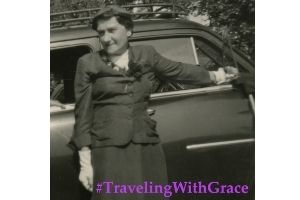
Welcome to this week’s segment of our 2019 #TravelTuesday series: Traveling with Grace. Today Grace shares her first visit to shore in the city of Algiers. As mentioned earlier, Grace’s language and word choices are not always progressive – this entry in particularly contains insensitive and classist language.
July 4, 1929
Algiers, North Africa. When we come out on our balcony this morning a beautiful scene greets our eyes. There on the shore of the blue Mediterranean hangs a diadem of pearls, the white houses of Algiers gleaming softly in the morning sunlight, tapering up to a point on the hills. Soon a number of little boats of every description are swarming around us and little boys and men, almost nude, are diving into the water for coins which are thrown to them. They look exactly like frogs swimming about, their agile bodies browned to a bronzy hue. Then there is laid a long pontoon bridge which is quickly lined with native merchants displaying their several wares, notably rugs, tapestries, articles in copper and brass, curved knives and silver jewelry. Over this bridge we cross to the shore. It is very got in the sun, a dry heat, but pleasant in the shade and when driving. The city is half French, half Arab. The architecture is predominantly Moorish, though in the European quarter the houses are strongly reminiscent of Paris and they even have a park named after the Bois de Boulogne.
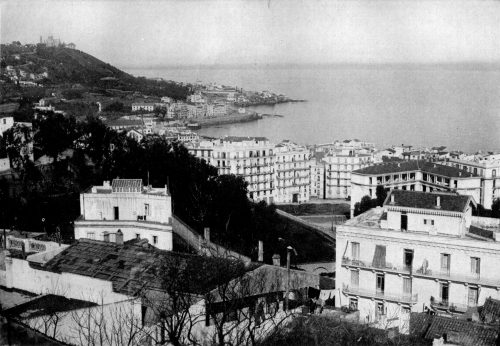
The Arab men wear the long white bernous, white turbans twisted around and around their heads, they are usually bare-footed and wear scraggly beards. The women are also swathed in white (not unfortunately spotless however), their faces veiled up to their eyes, no stockings but high-heeled slippers and a bracelet around each ankle. Nearly all of them carry babies. There are also a number of Turks wearing the red fez. These people are far from clean. Many of the little boys have monkeys on a leash and these are the commonest household pets. I was told they are caught over in the Atlas Mountains where they live wild. The manner of their capture is as follows: being very fond of nuts, they are enticed by gourds filled with this delicacy, into which they thrust a hand. With this hand full of nuts they cannot extricate it and they will not relinquish the prize. Thus struggling they are caught.

We visited a carpet factory where oriental rugs are manufactured. Little girls from five years of age up to ten or twelve work at the looms. At each loom are two little girls and one older girl who sits between. They follow their patters with rich and deep colors and make the knots with incredible speed. (It is pitiful to see such tots work but it teaches them a trade and keeps them from mischief or from begging on the streets.) Their long plaits are wrapped closely in strips of cloth, they look like a chinaman’s queue and this is to prevent the hair from getting mixed up with their threads. Some of the little girls are quite pretty in a dark, roguish way. They beg slyly when the forelady is not looking. Next door is a shop where they sell the rugs and also beautifully embroidered shawls, scarves and dresses of the purest wool.
We next visit the governor’s winter palace, archbishop’s palace, Cathedral and Post Office, all handsome structures in the Moorish style, richly ornamented with mosaics in which light blue and gold predominate against a white background, and slender fluted columns of marble. Heavy doors of hard wood are embellished with carvings and large copper nail heads. The walls are covered with lacy arabesques while tall minarets and sparkling domes dominate the exteriors. We ride through the old Arab quarter and look up the little side streets which are in reality narrow winding stairways over which the walls of the houses almost meet. They lead up to the Kasbah or fortifications on the top of the pyramid formed by the buildings.
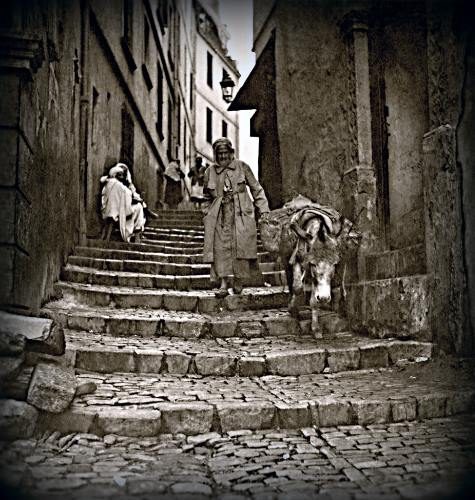
Here the natives live in the utmost squalor with no notion of sanitation. The wider thoroughfares are nearly all arcaded as a protection from the dazzling sunshine. Men are frequently seen sprawled out on the pavement fast asleep. We see the flea market where odds and ends of junk are sold and the produce market where the fruits and vegetables look very fine. We see a mosque and a synagogue, both similar in architecture. Most of the Jews look like Turks. On the principal shopping street, Rue de la Marine, are some pretty stores, the Bon Marche being similar to the one in Paris and the women seen in this section look very stylish. The Library, Opera House and National University are very nice buildings. We ride out in the open country, up through the hills where the breeze is blowing fresh from the sea. Here the vegetation is green and abundant. Numerous are the fruit trees of all kinds and there are very pretty farms, one we saw being the property of an American, Lovett Henn. There is a country club and extensive golf course, many of the villas are covered with the brilliant bouqainvillia via. We see the handsome summer residence o the Governor which commands a beautiful view, in fact there are many beautiful panoramas opening up form the hills down to the sea which remind me strongly of Nice and the Cote d’Azur. Palm trees abound and the air is fragrant with mimosa.
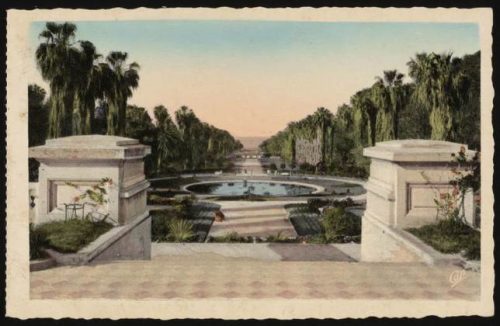
On our way back to Algiers we pass the Pasteur Institute where there are lots of cows and we visit the Jardin d’Essait or botanical gardens where the most beautiful tropical plants and trees are growing in almost wild profusion. There are huge hibiscus trees, magnolia, rubber, banyan bamboo, and a lovely tree bearing yellow flowers and thin fringe-like leaves. A part of the garden is laid out in formal French style copied from Versailles, and they are building a new museum of fine arts which, when completed, will look like the Trocadero. We ride along the Quai. Many of the better class homes facing the sea are closed as the wealthy inhabitants live elsewhere during the summer.
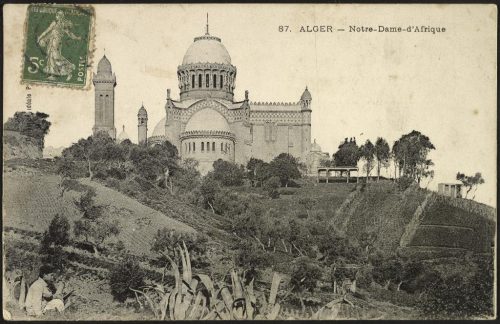
Crowning a high hill overlooking the sea, is the handsome Byzantine Cathedral of Notre Dame of Afrique Birkadem. Many of the Arab homes have flat roofs which serve as the family sitting room at night and here their poor women can unveil their faces and be comfortable. We go to call on the American Consul but do not find him in.
When we return to the ship, we find it full of visitors, this being its first visit to Algiers, they are holding open house and I think all of the European residents are availing themselves of the opportunity to inspect it. Refreshments are served to all. Tonight, a special dinner is served in honor of the 4th of July and the table are decorated with little Italian and American flags. Ice cream is served every night after the dance.
July 5, 1929: We are at sea again and this afternoon sight the Island of Sardinia. Tonight is the Captain’s dinner. Ship treats all to champagne.
Thanks for reading “Traveling with Grace,” a series where we’re sharing (and annotating) posts from the travel diaries of Grace Amelia Hecht, native Baltimorean, b. 1897 and d. 1955. Next week we pick up with the family as they visit Naples. As mentioned in my introductory post transcription errors sometimes occur and I’ve made my best guesses where possible, denoted by [brackets]. – Rachel Kassman, marketing manager
